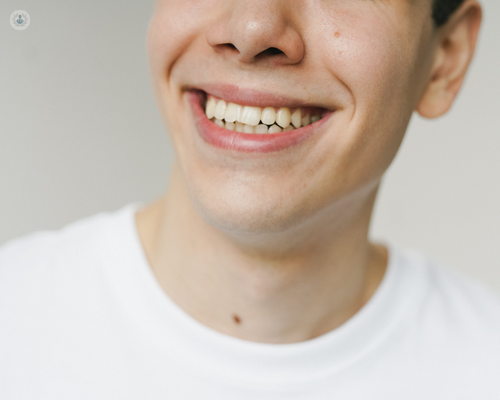Periodontal plastic surgery for correction of gum recession
Autore:Gum recession is a common dental condition where the gum tissue surrounding the teeth begins to wear away or pull back, exposing more of the tooth or even its root. This can lead to increased sensitivity, aesthetic concerns, and a higher risk of decay or infection. Periodontal plastic surgery offers an effective solution to correct gum recession, protect the teeth, and restore a natural gum line.

What is periodontal plastic surgery?
Periodontal plastic surgery is a specialised branch of dentistry within periodontal surgery, focused on improving the health and appearance of the gums and supporting structures. When it comes to gum recession, periodontal plastic surgery techniques are used to reposition or graft gum tissue to cover exposed tooth roots and protect against further gum loss.
The two main objectives of this surgery are:
- Aesthetic restoration: To improve the appearance of the smile by covering exposed roots and creating a more even gum line.
- Functional preservation: To protect the roots of teeth from decay, abrasion, and increased sensitivity that often accompany gum recession.
Why does gum recession occur?
Gum recession can result from various factors, such as:
- Aggressive brushing: Brushing too hard or using a hard-bristled toothbrush can wear away gum tissue over time.
- Periodontal disease: Gum disease, caused by bacterial infection, can destroy gum tissue and supporting bone.
- Genetics: Some people are more prone to gum recession due to hereditary factors.
- Poor oral hygiene: A build-up of plaque and tartar can cause gum inflammation, which may lead to recession.
- Teeth grinding or clenching: Excessive force on teeth due to grinding can also contribute to gum recession.
- Tobacco use: Smoking or chewing tobacco is associated with increased gum disease and gum recession.
What are the benefits of periodontal plastic surgery?
Periodontal plastic surgery for gum recession has numerous benefits, including:
- Reduced sensitivity: Covering exposed roots helps reduce sensitivity to hot, cold, or sweet foods and beverages.
- Protection from decay: Exposed roots are more vulnerable to decay. Covering them with gum tissue provides a protective barrier.
- Enhanced aesthetics: Receding gums can make teeth appear longer, impacting the appearance of a smile. Corrective surgery can restore a more balanced look.
- Improved oral health: Healthy gums are essential for overall oral health. By stabilising the gum line, surgery can help prevent further gum disease or recession.
How is periodontal plastic surgery performed?
The most common surgical methods for correcting gum recession include:
- Gum grafting: A small piece of tissue is typically taken from the roof of the mouth (or a donor source) and grafted onto the receding area to cover exposed roots. This tissue then integrates with the existing gum tissue, providing a new protective layer.
- Pinhole surgical technique (PST): This is a minimally invasive technique where a small hole is made in the gum tissue, and special instruments are used to loosen and reposition the gum tissue to cover the exposed root without requiring grafts.
- Connective tissue grafts: This is a type of gum grafting that involves taking tissue from under the skin in the palate and placing it over the affected area. It’s particularly effective for severe recession cases.
What can you expect during recovery?
Recovery after periodontal plastic surgery varies depending on the technique used and individual patient factors. In general:
- Patients may experience some mild discomfort, swelling or bruising, which can be managed with prescribed pain relievers and anti-inflammatory medications.
- Most people can return to normal activities within a day or two, though they may need to avoid certain foods and follow a soft diet temporarily.
- Good oral hygiene practices and a regular check-up schedule are essential to maintaining results and preventing further gum issues.
Are there risks associated with periodontal plastic surgery?
As with any surgical procedure, there are risks to be aware of, including infection, excessive swelling, or the graft failing to integrate with the existing gum tissue. However, complications are rare, especially when the procedure is performed by a qualified periodontist. Following your periodontist's post-operative instructions can help minimise any risks.
Is periodontal plastic surgery a permanent solution?
While periodontal plastic surgery can provide long-lasting results, it’s essential to maintain good oral hygiene and avoid factors that can contribute to gum recession, such as aggressive brushing and tobacco use. Regular dental check-ups, good oral care and professional cleanings are key to preserving the results.
Periodontal plastic surgery can significantly improve both the health and appearance of gums affected by recession. For patients dealing with gum sensitivity, aesthetic concerns, or the risk of tooth decay due to gum recession, this procedure offers an effective, long-term solution. Consulting with a periodontist can help determine the most suitable treatment and ensure a successful outcome in managing gum recession.


